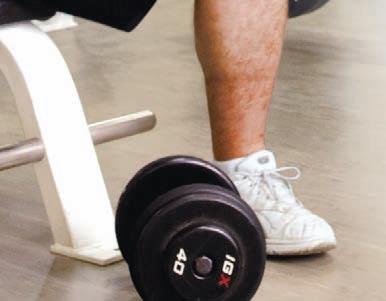
2 minute read
WEIGHT MANAGEMENT

Current trends show higher rates of overweight and obesity than ever before in U.S. history. Excess weight is linked with the risk of type 2 diabetes, hypertension, stroke, heart disease, and elevated cholesterol. Even osteoarthritis, which develops in joints with age, is aggravated by excess weight. Now that over one third of U.S. children are classified as overweight, it’s becoming impossible to ignore our collective weight problem.
How does this trend affect each of us, personally? Researchers at Columbia University found that overweight and obese women spend an average of three more years managing health problems than normal-weight women. Heavy men, on average, are sicker one more year than their thinner counterparts.


Dr. Tamika Perry of Uptown Health and Wellness says, “Weight loss isn’t rocket science. It’s all about what you take in with your diet, and what you use up with your activity. It’s a math equation. If you think about gasoline in your car, whatever you don’t use, you store it in the reserve tank. That’s when people gain weight.”
It may not be rocket science, but it’s not easy to change habits and lifestyles. “We help each patient figure out the right amount they need to eat, based on their activity,” says Dr. Perry. “Sometimes it’s hard for people to change what they’re used to eating cold turkey. Based on the person’s health patterns, we may or may not give medicine to suppress appetites.”

“I recommend my clients follow a natural eating plan,” Brumley says. “If it’s in a box, wrapped in plastic, processed – you want to stay away from it. If it’s vegetables, fruit, protein – those are green light foods.”
Brumley classifies whole grains as yellow-light foods. “Whole grains are a little bit controversial. I tend to stay away from wheat in general. Whenever I say carbohydrates, I’m talking about sweet potatoes, or rice - foods in less processed forms.”
Brumley says many people reduce their food intake below healthy levels without realizing it. “We see people that have been taking in 900 calories a day and working out for an hour – that’s just not enough to sustain your body. What happens is your body goes into conservation mode. It slows down metabolism, because we use energy whenever we move about in our daily activity.”
Nutrition accounts for seventy percent of success in losing weight. The other thirty percent is related to exercise. In contrast to most people’s expectation, new research shows that aerobic exercise is not the most effective when it comes to reducing body fat.
“Recently, fitness professionals are getting away from traditional cardio, long duration, aerobic activity, to shorter duration, highintensity anaerobic activities,” Brumley says.


“Aerobic” refers to exercise that efficiently burns calories by means of increased heart rate and the presence of oxygen in the system. “Anaerobic” refers to exercising at a higher rate than your body is ready for. Weight training is one example. High intensity anaerobic exercise should be impossible to continue beyond a short duration.

It can be confusing when modern science contradicts an entrenched belief, but remember, aerobics still contribute to fitness by increasing strength and endurance. Balance is the key.











